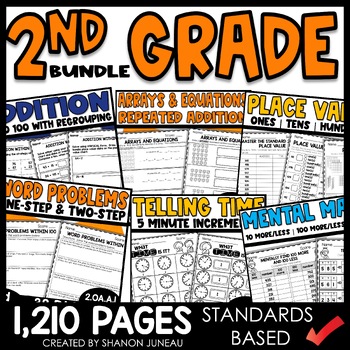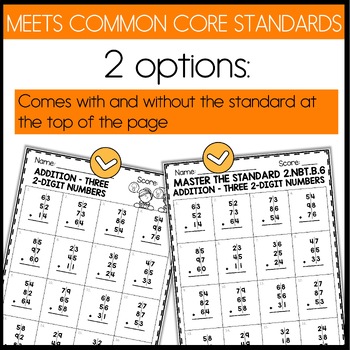Telling Time, Word Problems, Mental Math, Place Value 2nd Grade Math Worksheets
Shanon Juneau We are Better Together
11.2k Followers
Grade Levels
1st - 3rd, Homeschool
Resource Type
Standards
CCSS2.NBT.A.1
CCSS2.NBT.A.1a
CCSS2.NBT.A.1b
CCSS2.NBT.A.2
CCSS2.NBT.A.3
Formats Included
- Zip
Pages
1200+
Shanon Juneau We are Better Together
11.2k Followers
Products in this Bundle (17)
showing 1-5 of 17 products
Description
With over 1200 pages of standards-based math worksheets, these are a great way for you to check for understanding with a single-topic strategy. These cover place value ones, tens, and hundreds, word problems, addition and subtraction with and without regrouping, arrays, and much more!
SAVE 20% WHEN YOU PURCHASE THE BUNDLE!
COMES WITH:
- Math pages that have the standard at the top
- Math pages that don't have the standard at the top
COVERS:
- Addition and subtraction within 100 to solve one and two-step word problems
- Fluently add and subtract within 20
- odd or even numbers
- arrays and repeated addition
- Place value - ones, tens, and hundreds
- Count within 1000
- skip count by 5s, 10s, and 100s
- Base-ten numerals
- number names
- expanded form
- Compare three-digit numbers
- Fluently add and subtract within 100
- Add up to four two-digit numbers
- Add and subtract within 1000
- Mentally add 10 or 100 to a given number up to 900
GREAT FOR:
- Early Finishers
- Sub Tub
- Enrichment
- Remediation (RTI)
- Math Review
- Homeschool parents
SKILLS COVERED:
- 2.OA.A.1 Use addition and subtraction within 100 to solve one- and two-step word problems involving situations of adding to, taking from, putting together, taking apart, and comparing, with unknowns in all positions, e.g., by using drawings and equations with a symbol for the unknown number to represent the problem.
- 2.OA.B.2 Fluently add and subtract within 20 using mental strategies. By end of Grade 2, know from memory all sums of two one-digit numbers. Work with equal groups of objects to gain foundations for multiplication.
- 2.OA.C.3 Determine whether a group of objects (up to 20) has an odd or even number of members, e.g., by pairing objects or counting them by 2s; write an equation to express an even number as a sum of two equal addends.
- 2.OA.C.4 Use addition to find the total number of objects arranged in rectangular arrays with up to 5 rows and up to 5 columns; write an equation to express the total as a sum of equal addends.
- 2.NBT.A.1 Understand that the three digits of a three-digit number represent amounts of hundreds, tens, and ones; e.g., 706 equals 7 hundreds, 0 tens, and 6 ones. Understand the following as special cases:
- 2.NBT.A.1a 100 can be thought of as a bundle of ten tens - called a “hundred.”
- 2.NBT.A.1b The numbers 100, 200, 300, 400, 500, 600, 700, 800, 900 refer to one, two, three, four, five, six, seven, eight, or nine hundreds (and 0 tens and 0 ones).
- 2.NBT.A.2 Count within 1000; skip-count by 5s, 10s, and 100s.
- 2.NBT.A.3 Read and write numbers to 1000 using base-ten numerals, number names, and expanded form.
- 2.NBT.A.4 Compare two three-digit numbers based on meanings of the hundreds, tens, and ones digits, using >, =, and < symbols to record the results of comparisons. Use place value understanding and properties of operations to add and subtract
- 2.NBT.B.5 Fluently add and subtract within 100 using strategies based on place value, properties of operations, and/or the relationship between addition and subtraction.
- 2.NBT.B.6 Add up to four two-digit numbers using strategies based on place value and properties of operations.
- 2.NBT.B.7 Add and subtract within 1000, using concrete models or drawings and strategies based on place value, properties of operations, and/or the relationship between addition and subtraction; relate the strategy to a written method. Understand that in adding or subtracting three-digit numbers, one adds or subtracts hundreds and hundreds, tens and tens, ones and ones; and sometimes it is necessary to compose or decompose tens or hundreds.
- 2.NBT.B.8 Mentally add 10 or 100 to a given number 100–900, and mentally subtract 10 or 100 from a given number 100–900.
QUESTIONS OR CONCERNS
Email me at scjuneau@yahoo.com if you have any questions or concerns about this product.
WHO LIKES A DEAL?
- Follow me and be notified when new products are uploaded. New products are always 50% off for the first 24 hours they are posted (except for resources that are $1.50 and under). It pays to follow me!
Thank you for visiting my store! Please contact me if you have any questions!
I SURE APPRECIATE YOU!
Shanon Juneau ❤️
We Are Better Together
Elementary Hub Club
#2ndgrademathworksheets
#2ndgrademathcommoncorestandards
Total Pages
1200+
Answer Key
N/A
Teaching Duration
Lifelong tool
Report this resource to TPT
Reported resources will be reviewed by our team. Report this resource to let us know if this resource violates TPT’s content guidelines.
Standards
to see state-specific standards (only available in the US).
CCSS2.NBT.A.1
Understand that the three digits of a three-digit number represent amounts of hundreds, tens, and ones; e.g., 706 equals 7 hundreds, 0 tens, and 6 ones. Understand the following as special cases:
CCSS2.NBT.A.1a
100 can be thought of as a bundle of ten tens - called a “hundred.”
CCSS2.NBT.A.1b
The numbers 100, 200, 300, 400, 500, 600, 700, 800, 900 refer to one, two, three, four, five, six, seven, eight, or nine hundreds (and 0 tens and 0 ones).
CCSS2.NBT.A.2
Count within 1000; skip-count by 5s, 10s, and 100s.
CCSS2.NBT.A.3
Read and write numbers to 1000 using base-ten numerals, number names, and expanded form.





